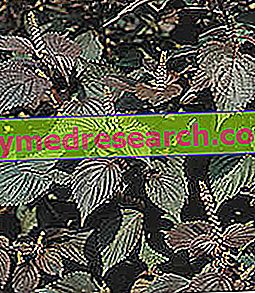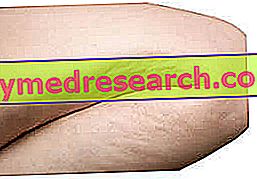Generality
What is perilla frutescens?
Perilla ( Perilla frutescens ) is an annual herbaceous plant belonging to the Labiate family.

What is perilla oil?
Perilla oil is a clear yellow, clear and transparent liquid with a typical and characteristic odor.
Chemical characteristics of perilla oil
Perilla oil is very rich in:
- Unsaturated fatty acids (polyunsaturated and monounsaturated)
- Phytosterols
- Polyphenols
- Vitamin E.
The properties of perilla oil are mainly related to its beneficial fatty acids, antioxidants and phytosterols.
LIPID PROFILE OF PERILLA OIL
- Alpha linolenic acid (ALA omega 3): 52-64%
- Oleic acid (OA omega 9): 12-22%
- Linoleic acid (LA omega 6): 11-16%
- Gamma linolenic acid (GLA omega 6): 0-1%.
Saturated fatty acids are present to a much lower extent:
- Palmitic acid (PA): 5-7%)
- Stearic acid (SA): 1-3%.
Like all vegetable oils, perilla oil is cholesterol-free but instead we find plant sterols called phytosterols.
Perilla seeds also contain powerful antioxidants such as polyphenols and vitamin E.
PERILLA OIL AND OMEGA ESSENTIAL FATTY ACIDS 3
Perilla oil is one of the richest sources of alpha linolenic acid, comparable only to linseed oil and other oils with less commercial appeal.
As shown in the table, good sources of these nutrients are also hemp oil, canola oil, walnut oil and soybean oil.
| Content of ω3 expressed as% of ALA in seed oils | ||
| Common name | Scientific name | % of ω3 |
| Chia oil | Salvia hispanica | 64 |
| Kiwi oil | Actinidia chinensis | 62 |
| Perilla oil | Perilla frutescens | 58 |
| Linseed oil | Linum usitatissimum | 55 |
| Cranberry Oil | Vaccinium vitis-idaea | 49 |
| Camellia oil | Camelina sativa | 36 |
| Portoluca oil | Portulaca oleracea | 35 |
| Black Raspberry Oil | Rubus occidentalis | 33 |
| Hemp Oil | Cannabis sativa | 20 |
| Canola oil | Brassica napus | 10 |
| Soybean Oil | Glycine max | 8 |
PERILLA OIL: OMEGA 3 AND HEALTH
As we have already said, perilla and even perilla oil are very rich in alpha linolenic acid.
This essential lipid (ie that cannot be synthesized by the body) is a precursor of two derivatives, called eicosapentaenoic acid (EPA) and docosahexaenoic acid (DHA).
The food sources of EPA and DHA are essentially fish: salmon, blue fish and species that inhabit cold sea waters, along with their oils, are the main contributors to this.
As we have anticipated, EPA and DHA can also be obtained from within the human organism, by enzymatic means, starting from alpha-linolenic acid; however sometimes this ability remains compromised, exposing to nutritional deficiency.
Omega 3 perform vital and healthy functions. Some are: they constitute the cellular membranes, they are necessary for the brain and ocular development of the fetus and the child, anti-inflammatory, fluidifying and anti-aggregation, they protect the endothelium of blood vessels, vasodilators, reduce triglyceridemia and arterial pressure, hinder the damage of hyperglycemia and type 2 diabetes mellitus, protect against cardio-cerebrovascular events, preserve cognitive function and improve certain types of depression, etc.
It must be remembered that most of the health benefits attributed to omega three are related to the role of EPA and DHA in the body.
Several studies have shown that alpha linolenic acid is converted into EPA and DHA with a fairly low efficiency, estimated at 5-10% for EPA and 2-10% for DHA, respectively.
This conversion capacity decreases with aging, in the case of a diet rich in linoleic acid (due to enzymatic competition), and in the course of certain diseases (diabetes, allergies).
The typical western diet is characterized by a clear imbalance between the intake of omega six - abundantly contained in commonly used vegetable oils (corn, sunflower, soy, peanut) and that of omega three.
Although omega 6 perform important functions in the body, an excessive intake of those with a pro-inflammatory effect can fuel inflammatory states, revealing themselves to be detrimental to the patient's general health.
To learn more, we recommend reading the article: the right relationship between omega six and omega three.
Indications
When to use Perilla frutescens or Perilla Oil?


Traditional Chinese medicine recommends perilla as a remedy for diarrhea, but also for flu, anemia, rheumatism, blood circulation and neuralgia.
PERILLA IN PHYTOTHERAPY AND NUTRACEUTICS
Modern phytotherapy and nutraceutical science use perilla as a vegetable source of omega three fatty acids, seeking all the benefits of integrating these essential nutrients for the human body.
Does Perilla frutescens have other uses?
PERILLA AS FUEL
Perilla oil is also used as an alternative fuel and in the paint, paint and ink industries.
PERILLA AS FORAGE
What remains of the seeds after the extraction of the oil, the so-called panel, is recycled in feeding the livestock.
Property and Effectiveness
What are the properties of perilla and perilla oil?
The benefits of perilla oil are attributable to the generous intake of omega three and antioxidant substances (polyphenols).
Although not shown for perilla oil in particular - however it is effective in treating many allergic diseases: from atopic dermatitis to bronchial asthma up to chronic intestinal inflammatory diseases - there are several benefits that can be attributed to a dietary supplement of omega three:
- Reduction of cardiovascular risk: lower blood pressure, reduce blood triglyceride levels, participate in the fight against atherosclerosis and it is possible that they reduce arrhythmias as well as the risk of thrombosis
- Reduction of the body's inflammatory state: they could have potentially beneficial effects in case of allergies, premenstrual syndrome, dysmenorrhea, Crohn's disease, ulcerative colitis, rheumatoid arthritis, lupus, psoriasis
- Better stress control, reduction of cortisol levels in stressed subjects, with increased mood in case of anxiety and especially depression.
Lastly, it should be noted that omega-3 rich vegetable oils - although disadvantaged by the absence of EPA and DHA - do not present the risk of contamination by heavy metals and dioxins, which is specific for fish oils.
Furthermore, compared to the latter, perilla oil and other vegetable oils rich in omega-three take advantage of their suitability for vegan consumption and the absence of "fishy taste refluxes", which are poorly tolerated by some.
PERILLA OIL: PHYTOSTEROLS AND HEALTH
Perilla and perilla oil are rich in phytosterols.
These lipids have a positive metabolic function because they help decrease the absorption of dietary cholesterol.
PERILLA OIL: VITAMIN E and POLYPHENOLS FOR HEALTH
Perilla and perilla oil contain high doses of polyphenols.
In particular, there are: quercitin, catechin, apigenin, rosmarinic acid, luteolin and crisoeriol.
These nutritional principles are powerful antioxidants.
The same effect, although thanks to a different mechanism, is exercised by vitamin E or tocopherol which is also present in perilla and perilla oil.
All these nutritional principles combine to keep the product from oxidation and the consequent rancidity. Similarly, once taken with the diet, these substances neutralize the excess of free radicals within the body.
Doses and Mode of Use
How to use perilla oil?
Perilla oil, which was once available mainly in liquid form, is now distributed in capsules or capsules.
Given the needs suggested by the LARNs and the Food and nutrition Board, a daily intake of 2-4 grams of Perilla frutescens oil is recommended.
Side effects
The side effects of perilla oil supplementation are very low or almost zero.
Some gastrointestinal discomforts may occur, however more frequent in the supplement with EPA and DHA; for example: belching, nausea, abdominal cramps, dyspepsia and diarrhea.
Complications of the blood coagulation system are rare.
They appear to be very rare and linked exclusively to overdoses, metabolic peroxidosis and other serious disorders.
Contraindications
When should perilla oil not be used?
Perilla oil should not be used in case of allergy or hypersensitivity linked to the components of the product.
It is advisable to pay close attention to the combination of perilla oil (and omega three in general) with some drugs (see below).
Considering the anticoagulant effect of omega 3, in particular of the EPA derivative, excessive consumption of perilla oil can facilitate the risk of spontaneous bleeding or following minimal trauma. The risk mainly involves patients already in therapy.
Pharmacological Interactions
Which drugs or foods can modify the effect of perilla oil?
The drugs with which it is not advisable to take considerable doses of perilla oil are:
- Anticoagulants (coumadin, sintrom, acenocumarol), aspirin, non-steroidal anti-inflammatory drugs, garlic and ginkgo biloba: they would increase the risk of bleeding due to the double anti-aggregating effect.
- Oral hypoglycemic agents: it is advisable to consult your doctor before starting the alpha linolenic acid supplement, even if the hypoglycemic power, mainly linked to the function of EPA and DHA, is not well defined and sometimes seems of little relevance.
Precautions for Use
What do you need to know before taking perilla oil?
Before starting the integration with perilla oil it is important:
- Evaluate if it is really necessary
- Consider what is mentioned in the side effects, contraindications and drug interactions
- Consult your doctor, especially in the case of pregnancy, breastfeeding, pediatric age (despite the clear advantages offered by omega 3 in developing the fetus and younger children), pathologies and pharmacological treatments.
It is advisable to stop taking perilla oil before surgery to avoid the risk of excessive bleeding.



